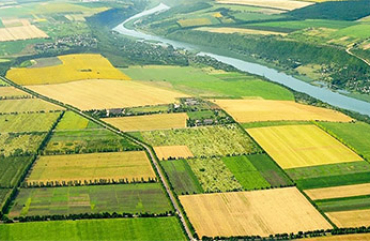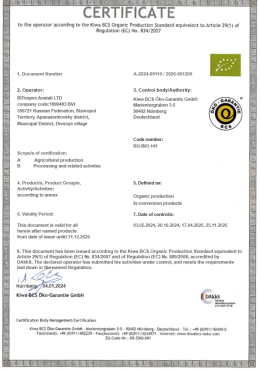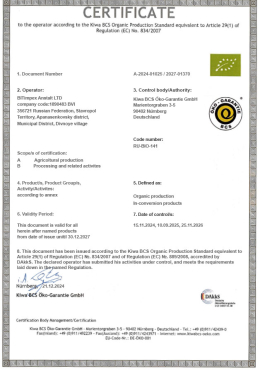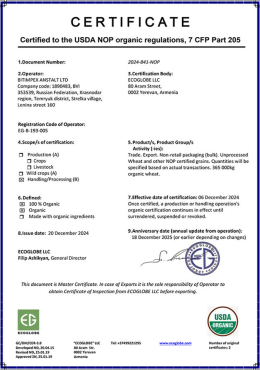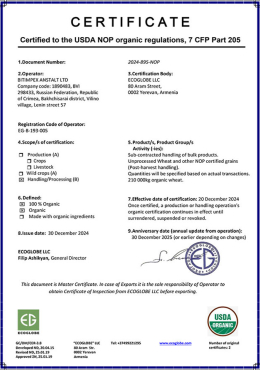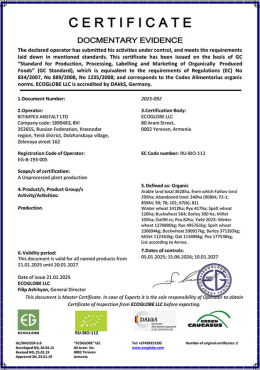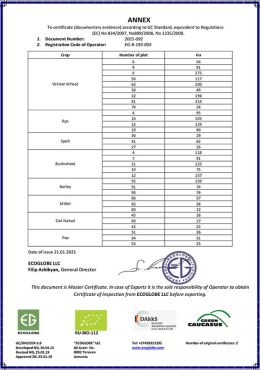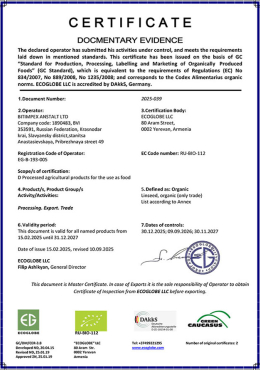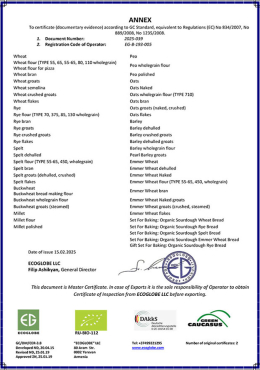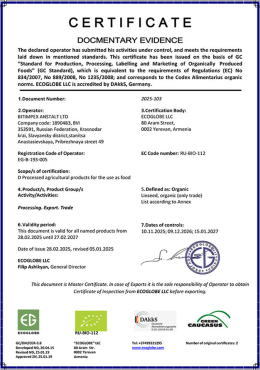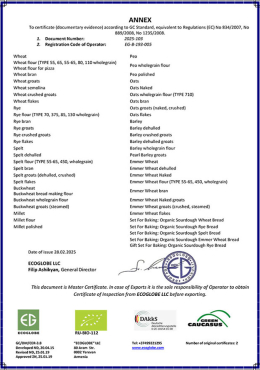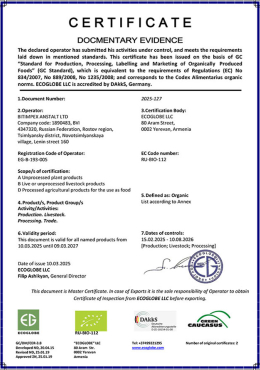European Certification
- Agriculture
- Our Elevators
- Our Certificates
- Our Diplomas
- Organic certification
- European Certification
- Halal Certification
- Wheat - Wheat flour - Mills
- Buckwheat - Buckwheat flour
- Linen Seeds
- Corn – Сorn flour
- Oats – Oat flour
- Rye – Rye flour
- Barley – Barley flour
- Sunflower seed
- Chickpeas, Peas – Pea flour
- Beans
- Soybean seeds
- Pumpkin seeds
- Rape seeds
- Sugar beet pulp
- Beer pellets
- Meal for animal feed
- Production plant L-lysine, Gluten, Alcohol, DDGS, CO2
- Sugar Factory
- Oil Extraction Factory
- Rice Processing Plant
- Milk Powder Production Plant
- Meat Processing Plants
- Fruit Storages
- Bioproducts Plant
- Malt plant
- Cheese production plant
- Aquaculture feed production plant
- Cold Storage and Meat Processing Plants
- Cattle - meat beef
- Pig breed - Pork meat
- Sheep breeds - lamb meat
- Poultry meat
- Chicken egg
- Quail
- African chicken, cisar hen
- Geese meat
- Our beegarden
- Honey
- Bee products
- Gardens
- Containers, packaging and calibration
- Factory for the production of juices and tomato paste.
- Quince
- Pear
- Peaches
- Plum
- Cherry
- Apples
- Apricot
- Berries
- Grape
- Figs
- Mulberry
- Nuts
- Almond
- Watermelon cultivation technology
- Melons
- Transportation
European Certification
Euro-leaf
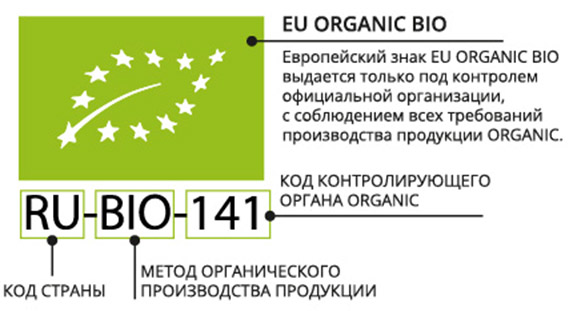
In what cases is Euro-leaf used? The main purpose of eco-labeling is to notify the consumer that this is an organic product and to prevent all sorts of confusion with labeling.
The Eurolist was introduced by European Union Commission Regulation No. 271/2010 of March 24, 2010.
The eco-label must be used on all packaging of goods produced and sold in the European Union. Additional labeling may be used for imported products that comply with EU rules on the import of organic goods. The use of labeling is regulated by Article 57 of European Union Commission Regulation No. 889/2008, that is, if there is a Euro-list sign, it means that this is an ecological product from the Russian Federation. This means that the Russian ORGANIC badge should also appear.
This label guarantees at least 95% organic ingredients and is primarily non-GMO.
Euro-list (EU Organic Bio) is currently the most common label not only in Europe, but also in many countries around the world.
The EURO-LEAF mark is mandatory for all organic products sold in the European Union.
This system was introduced in Europe in 2000.
To obtain this organic certificate, an agricultural enterprise must be managed in accordance with the rules of organic farming and undergo a series of voluntary inspections. The Euro-list certificate establishes uniform and clear requirements for the introduction of organic farming and guarantees compliance with all necessary standards to the consumer. Other countries that are not members of the European Union, but supply organic products on its territory, are also required to fulfill the specified conditions and undergo voluntary certification.
Prohibited Ingredients:
- GMO products,
- chemical fertilizers,
- harmful synthetic components,
- sulfates,
- silicones,
- petroleum products and so on.
Allowed Ingredients– ingredients included in the list of permitted substances according to the unified EU standard, natural fertilizers.
The general principles for successfully passing inspections are the refusal to use chemicals in the cultivation and production of products, the use of traditional farming methods, and respect for the environment. Maintaining a deficit-free natural cycle of resources and biodiversity. The conversion period for enterprises to switch to an organic farming system according to the Eurolist standard is 3 - 4 years. Bitimpex Anstalt holding received the Organic Bio certificate without going through a conversion period. After passing certification, the enterprise must label products according to clear rules: indicate the logo of the country of origin, production method, origin of raw materials and the code of the regulatory authority. All this is mandatory and otherwise the certificate will be revoked.
Bitimpex Anstalt has four European organic certificates from KIVA BSC is an international certification body. On 21,250 hectares of fallow land. There are also three certificates from the international certification body Ecoglobe for all organic lands with an area of 21,250 hectares, crop and livestock products, as well as an extended list of other products that are produced at our enterprises in four regions of Russia.
Types of Eco signs
Euro-leaf is a new mark of the European Organic Certification System, which was changed in 2010. The system itself was approved in March 2000 by the European Commission. The label is required for all organic products sold in the European Union.
In addition to the mark itself, the product label must contain information about the place of production. There are three designations: “EU Agriculture” (in the territory of the EU), “non-EU Agriculture” (in the territory of third countries, but in accordance with the rules defined for EU countries) and “EU/non-EU Agriculture” (both the EU and third countries, in accordance with the rules defined for EU countries). Important: if more than 98% of the materials making up the product were grown in the EU, then the country of origin will be indicated on the packaging.
From July 1, 2012, “Eurolist” was supposed to replace all national logos of EU countries, but many of them still exist in parallel.
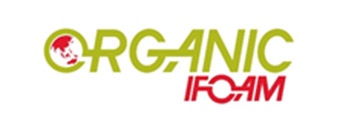
In February 2011, IFOAM introduced its organic guarantee system and introduced a new global quality mark, the Global Organic Mark.
According to the organization, too many organic labels lead to consumer confusion, so IFOAM proposed to use its own label and standards throughout the world.
National certification systems for organic products.
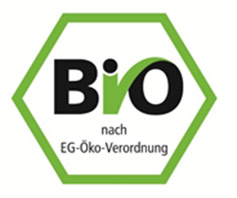
The German national mark "Bio-Siegel" has been in use since September 2001. Only producers who comply with the requirements of the EU Organic Farming Regulation and mandatory checks are allowed to sell their products as organic, natural and ecological products and, accordingly, label them with the special Bio-Siegel mark.
For German buyers, the presence of such a mark is more important than the EU mark, because the quality requirements for organic products in Germany are higher than in the EU. But if both signs are present on the package at once, then this is obviously even better
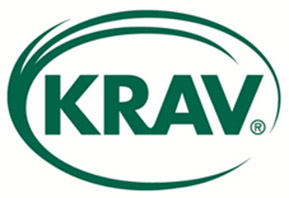
The Swedish mark "KRAV" was adopted in 1985 for labeling agricultural products. Controlled by the Swedish Agricultural Administration and the Swedish National Food Department. About 3 thousand farmers and 450 companies have the right to use/promote KRAV certified products.
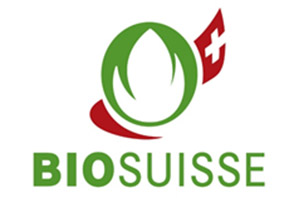
The Swiss “The BIO Suisse Bud” and “The BIO-Bud” are used to label organic products sold in the country. In Switzerland, more than 760 companies have received the right to use “The BIO Suisse Bud”. Each company's product has received the right to use “The BIO Suisse Bud”. Each product is marked with a certificate number and the name of the certifying authority.
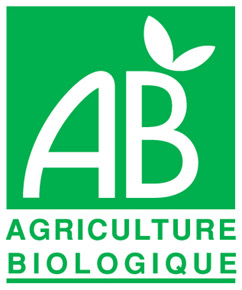
French "AB" sign (short for Agence Bio - French Agency for the Development and Promotion of Organic Agriculture). Agence Bio is a public interest group responsible for the development and promotion of organic agriculture.
Products bearing this mark are guaranteed to contain more than 95% organic ingredients. Also, the products must be grown in the EU (exotic products are an exception)
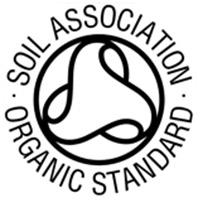
The English Soil Association standard was developed in the UK by the Soil Association in 1946. The Soil Association certificate is very authoritative in Europe - not only food products are certified, but also cosmetics, catering establishments, catering stores, shops.
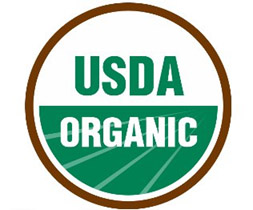
American USDA organic is the National Organic Standard, developed by the US Department of Agriculture. It was adopted as part of a national program for the transition of American citizens to the consumption of healthy and natural organic products, so its uniqueness is that it is fixed at the state level.
Only specialists from the US Department of Agriculture have the right to certify it.
The standard was originally created for food products, but now it is also used to certify cosmetics.
It is also used to confirm the environmental compliance of exported or imported products, so it is valid not only in the United States.
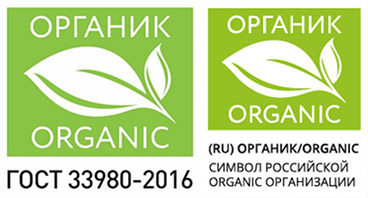
RU ORGANIC, Russia.
Russian labeling of certified organic products.
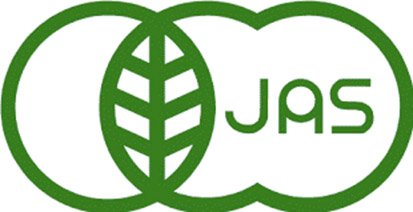
JAS, Japan.
How to distinguish organic products from conventional ones?
It is necessary to find an official eco-label on the packaging. Eco brands of some countries are listed in our information sheet.
Eco labeling indicates that the company has an organic certificate. If you see other signs, then these are signs of fraud and counterfeiting.
You can check the authenticity of a certificate in two ways:
request a certificate from the manufacturer and check its validity period
Check the availability of the certificate yourself using online resources or databases.
For each certificate, you can find out all the relevant information on the websites of the certification bodies.


